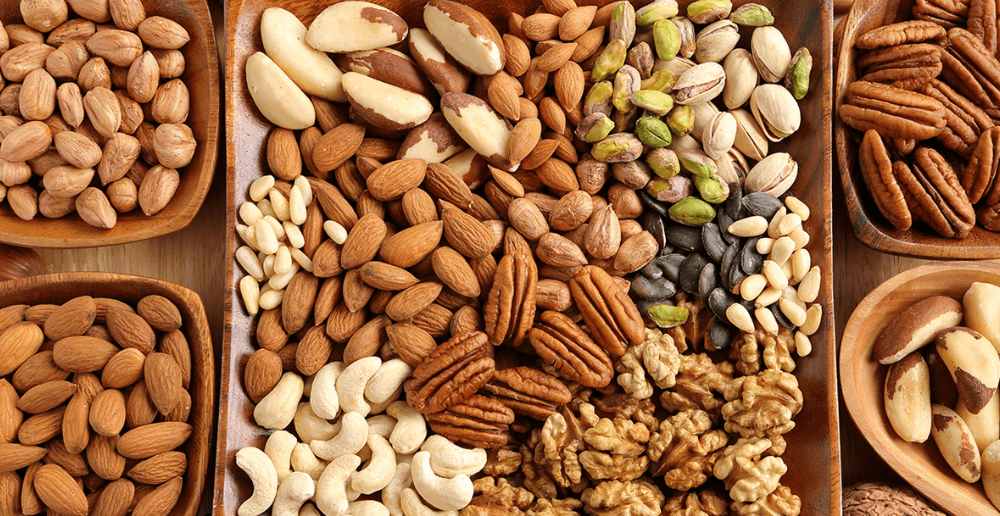Go ahead, get nutty

By Lise Timmerman
Winnipeg Regional Health Authority
Published Friday, June 7, 2019
If you are looking for an easy and tasty way to improve your health and well-being, why not try incorporating some nuts into your diet?
Random controlled trials (the gold standard in research), meta-analyses of clinical trials and observational studies have repeatedly shown that people who eat a small handful of nuts either daily or several times a week receive numerous health benefits.
For example, a 2017 study published in the Journal of the American College of Cardiology pooled the analysis of three large observational studies. It revealed that higher consumption of total and specific types of nuts helped reduce risk of cardiovascular disease (CVD) and coronary heart disease (CHD). “As compared with those participants who never or almost never consumed nuts, those who consumed nuts five or more times per week had 14 per cent lower risk of CVD and 20 per cent lower risk of CHD,” the study said.
Nut consumption has similarly been associated with positive findings for cholesterol levels and hypertension (high blood pressure).
And these health benefits aren’t restricted to a few types of nuts. Important health-promoting nutrients can be found in pretty much all varieties, including almonds, Brazil nuts, cashews, hazelnuts, macadamia nuts, pecans, pine nuts, pistachios, walnuts, peanuts, and their butters. (Although peanuts are a member of the legume family, they are included as a nut due to their comparable nutrient profiles.)
While each nut offers slightly different nutrient profiles, all are rich in the following:
- Protein: The plant-based protein found in nuts helps to build and repair body tissue as well as produce infection-fighting antibodies. It also helps promote satiety. Nuts vary in protein content; a quarter cup of almonds contains eight grams of protein whereas a quarter cup of peanuts contains 10 grams of protein.
- Fibre: Known mostly for helping to regulate your digestive system, fibre also promotes satiety and can help reduce low-density lipoproteins (LDL) cholesterol, known as “bad” cholesterol because it can clog up your arteries and cause heart disease. A quarter cup of nuts contains two to four grams of fibre.
- Fat: The monounsaturated fat found in nuts can help reduce the risk of developing heart disease. These heart-healthy fats are linked to lowered blood cholesterol, better blood sugars and also promote satiety
- Phytosterols: Nuts naturally contain phytosterols, or plant sterols, which help to reduce cholesterol levels.
Antioxidants: Nuts provide antioxidants such as vitamin E and flavonoids. These have a protective effect against cancer and heart disease.
Canada’s Food Guide, which was updated earlier this year,encourages us to eat raw or dry roasted (without oil) nuts and their butters in a more natural state without any added sugar, sodium (salt) or oils. Ideally, the nut is the only ingredient on the label.
Nuts are nutrient rich but also energy rich, which means they are high in fat and calories. Those calories can add up quickly, so a small amount – about a handful of shelled nuts – is all you need.
Nuts can add flavour, variety and interest to meals and snacks. Enjoy them whole, chopped, ground, powdered or as nut butter.
Roasting nuts enhances their flavour. Contrary to popular belief, roasting does not destroy the inherent health benefits. Nuts can easily be roasted in a dry frying pan over medium to high heat or in a 350 F oven until golden brown. Watch closely as this process takes only a few minutes and the nuts can burn quickly.
Here are some ways to add nutty goodness to your meals and snacks:
- Make your own trail mix by combining different nut varieties with dried fruits.
- Add nut butters or powdered versions to smoothies, yogurt, dry/hot cereals, and even sauces or soups.
- Sprinkle nuts on top of salads, stir-fries, casseroles, yogurts and cereals for added crunch.
- Try ground nuts as a breading for meats and fish fillets.
- Add a variety of nuts to your favourite baked goods.
All nuts store well in cool, dry place or the freezer and can fit into any healthy eating pattern. Be creative and enjoy. For more information on nuts or other food and nutrition topics please contact Dial-a-Dietitian in Winnipeg at 204-788-8248 or toll free at 1-877-830-2892.
Lise Timmerman is a registered dietitian with the Provincial Health Contact Centre’s Dial-a-Dietitian program located at Misericordia Health Centre.

